 A few years ago, when the first French fondue restaurant opened in Edmonton, I recall the amount of hype it received in the community. Everyone around me was bringing their spouse, children, friends, and relatives to gather around a pot dipping their various entrees into liquified cheese. The sight reminded me of my days in Shanghai, where the same type of hype was garnered around hot pot restaurants. Hot pot is Chinese-style fondue with vegetables and meat cooked in steaming pot of soup in lieu of cheese. Similar variations can be found in Japanese, Thai, and other south Asian cuisines each with their unique twists. The whole experience is relaxing and entertaining. The cost at local restaurants average from $23-$30 for an all-you-care-to-eat meal which makes it an extra bang-for-your-buck deal. However, for those who prefer to enjoy this in the comfort of your own home, we made a tutorial just for you.
A few years ago, when the first French fondue restaurant opened in Edmonton, I recall the amount of hype it received in the community. Everyone around me was bringing their spouse, children, friends, and relatives to gather around a pot dipping their various entrees into liquified cheese. The sight reminded me of my days in Shanghai, where the same type of hype was garnered around hot pot restaurants. Hot pot is Chinese-style fondue with vegetables and meat cooked in steaming pot of soup in lieu of cheese. Similar variations can be found in Japanese, Thai, and other south Asian cuisines each with their unique twists. The whole experience is relaxing and entertaining. The cost at local restaurants average from $23-$30 for an all-you-care-to-eat meal which makes it an extra bang-for-your-buck deal. However, for those who prefer to enjoy this in the comfort of your own home, we made a tutorial just for you.
Equipment needed:
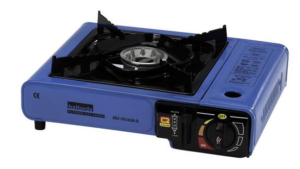 Although not required, the pot is typically heated through a portable gas or electric stove. Cooking the meal over the stove is possible, but doing that will lose the communal aspect of group-cooking around the table. For the beginner, cooking around the stove can be an option, but if you want the full experience, a portable electric or gas stove is recommended.
Although not required, the pot is typically heated through a portable gas or electric stove. Cooking the meal over the stove is possible, but doing that will lose the communal aspect of group-cooking around the table. For the beginner, cooking around the stove can be an option, but if you want the full experience, a portable electric or gas stove is recommended.
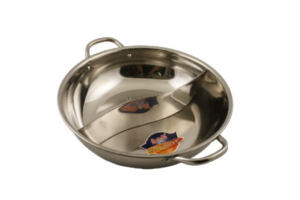 The next step is to retrieve a pot. For the average hot-potter, a medium sized stainless-steel pot will do. However, the Chinese take their hot pot seriously, so they utilize a special pot divided into two compartments so that guests have the option of cooking food in two different broths.
The next step is to retrieve a pot. For the average hot-potter, a medium sized stainless-steel pot will do. However, the Chinese take their hot pot seriously, so they utilize a special pot divided into two compartments so that guests have the option of cooking food in two different broths.
For scooping utensils, a ladle is a minimum requirement to help fish out the contents. Unlike the French fondue we don’t have the luxury of using skewers, so a ladle or a strainer ladle is preferred. Personally, I prefer using a strainer ladle which drains the broth when the items are ready to eat.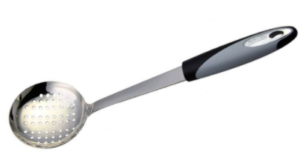
Once you have successfully scooped the contents of the pot up into your individual bowl or plate, you may use any eating utensil preferred (with the exception of your hands, as the contents tend to be hot, hence the name).
Ingredients needed:
The best part of your hot pot experience is that is it 100% customizable. You’re not confined to a certain type of protein or vegetable so pick liberally. There’s also no limit as to the number of ingredients you chose to have. If you’re catering a large crowd, you may have a dozen different items. For me, the magic number I aim for to serve 1-3 people is around 5 items.
My pick of vegetarian choices:
- Enoki mushrooms or white mushrooms
- Potato slices
- Iceberg lettuce
- Cucumbers
- Spinach
- Tofu
- Vermicelli noodles
My pick of proteins:
- Thinly sliced beef shank
- Thinly sliced lamb shank
- Meatballs
My pick of seafood (optional):
- Shrimp
- Imitation crab
- Dried seaweed
- Thinly sliced salmon
- Fish tofu
Besides your favorite ingredients, you will also need to purchase the soup base. The soup base typically comes in packages at the local supermarket. The soup base is the most critical part of hot pot and is rich with spices, herbs, and seasoning oils. Without this integral part, your hot pot simply would not fly. They look something like this:
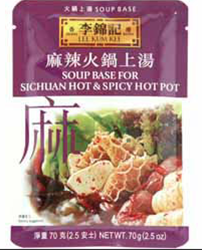
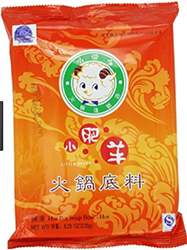
Cooking instructions:
- Once your ingredients have been prepared on plates, your following steps are the most enjoyable moments of your dining experience.
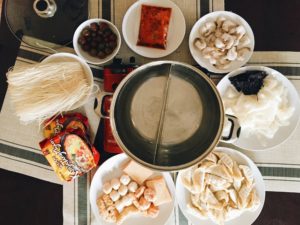
- First, crank up the heat on the cooking surface (be a stove or portable hot plate)
- As soon as the heat has been turned on, add a soup base and wait for the mix to boil
- When the broth begins to boil, add cold or frozen ingredients first (frozen shrimp, frozen beef or chicken slices)
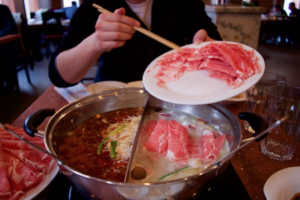
- When the water boils again, the contents are ready to be served.
- Repeat the previous steps and continue cooking until you and your guests are full
Word of caution:
The fastest way to ruin your hot pot experience is to burn yourself. There’s a reason it’s named “hot pot”, for the contents are boiling. Be careful when serving yourself and others. Secondly, if you’re using a gas stove, make sure you have a carbon monoxide detector to avoid carbon monoxide poisoning. Finally, cook your food thoroughly in the pot to avoid food poisoning.


